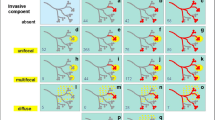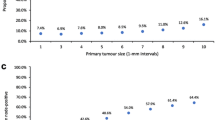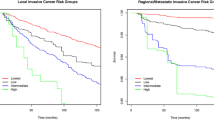Abstract
It has been proposed that a proportion of non-palpable breast cancers that are diagnosed through mammography represents a very low-risk subgroup of cancers that may not affect survival (overdiagnosis). The salient pathologic features of cancers in this theoretical subgroup are not known, and therefore, it is not possible to predict which patients have a cancer of this type. We reviewed the clinical characteristics and survival experiences of 715 patients with an invasive breast cancer of 5.0 cm or less. The tumour from each patient was represented in triplicate on a tissue microarray. Cases were divided into low-risk and moderate-/high-risk categories based on lymph node status and palpability. Low-risk cancers were those that were non-palpable, node-negative and were only detected by mammographic screening. All other cancers were high/moderate risk. The two groups of cancer patients were compared for a number of tumour characteristics, based on immunohistochemistry. There were 79 low-risk cancers and 636 moderate-/high-risk cancers. The low-risk cancers were characterized by ER-positivity, PR-positivity, HER2-negativity, ck5/6-negativity, EGFR-negativity and p53-negativity. About 54 of the 79 low-risk cancers (68 %) were of the luminal A subtype versus 335 of 636 moderate-/high-risk cancers (53 %; p = 0.008). Among 42 women with a non-palpable, mammogram-detected PR+ HER2– cancer of 5.0 cm or less, the 15-year distant recurrence-free survival rate was 100 %. Small breast cancers that are PR+ and HER2– and that are detectable by mammogram alone have a very low risk of recurrence. A proportion of these may represent examples of overdiagnosis.


Similar content being viewed by others
References
Zahl PH, Gøtzsche PC, Mæhlen J (2011) Natural history of breast cancers detected in the Swedish mammography screening programme: a cohort study. Lancet Oncol 12:1118–1124
Welch HG, Black WC (2010) Over-diagnosis in cancer. J Natl Cancer Inst 102:605–613
Narod S (2012) Disappearing breast cancers. Curr Oncol 19:59–60
Nofech-Mozes S, Trudeau M, Kahn HK, Dent R, Rawlinson E, Sun P, Narod SA, Hanna WM (2009) Patterns of recurrence in the basal and non-basal subtypes of triple-negative breast cancers. Breast Cancer Res Treat 118:131–137
Dent R, Trudeau M, Pritchard KI, Hanna WM, Kahn HK, Sawka CA, Lickley LA, Rawlinson E, Sun P, Narod SA (2007) Triple-negative breast cancer: clinical features and patterns of recurrence. Clin Cancer Res 13:4429–4434
Dent R, Hanna WM, Trudeau M, Rawlinson E, Sun P, Narod SA (2009) Time to disease recurrence in basal-type breast cancers: effects of tumor size and lymph node status. Cancer 115:4917–4923
Sørlie T, Perou CM, Tibshirani R, Aas T, Geisler S, Johnsen H, Hastie T, Eisen MB, van de Rijn M, Jeffrey SS, Thorsen T, Quist H, Matese JC, Brown PO, Botstein D, Eystein Lønning P, Børresen-Dale AL (2001) Gene expression patterns of breast carcinomas distinguish tumor subclasses with clinical implications. Proc Natl Acad Sci USA 98:10869–10874
Narod SA (2011) Age of diagnosis, tumor size, and survival after breast cancer: implications for mammographic screening. Breast Cancer Res Treat 128:259–266
Tovey SM, Brown S, Doughty JC, Mallon EA, Cooke TG, Edwards J (2009) Poor survival outcomes in HER2–positive breast cancer patients with low-grade, node-negative tumours. Br J Cancer 100:680–683
Blows FM, Driver KE, Schmidt MK, Broeks A, van Leeuwen FE, Wesseling J, Cheang MC, Gelmon K et al (2010) Subtyping of breast cancer by immunohistochemistry to investigate a relationship between subtype and short and long term survival: a collaborative analysis of data for 10,159 cases from 12 studies. PLoS Med 7(5):e1000279
Foulkes WD, Stefansson IM, Chappuis PO, Bégin LR, Goffin JR, Wong N, Trudel M, Akslen LA (2003) Germline BRCA1 mutations and a basal epithelial phenotype in breast cancer. J Natl Cancer Inst 95:1482–1485
Crook T, Crossland S, Crompton MR, Osin P, Gusterson BA (1997) p53 mutations in BRCA1-associated familial breast cancer. Lancet 350:638–639
Warner E, Hill K, Causer P, Plewes D, Jong R, Yaffe M, Foulkes WD, Ghadirian P, Lynch H, Couch F, Wong J, Wright F, Sun P, Narod SA (2011) Prospective study of breast cancer incidence in women with a BRCA1 or BRCA2 mutation under surveillance with and without magnetic resonance imaging. J Clin Oncol 29(13):1664–1669
Acknowledgments
We thank the Canadian Breast Cancer Foundation (Ontario Chapter) for support of the Henrietta Banting database. We thank Ellen Rawlinson for maintaining the Banting database.
Conflict of interest
The authors declare that they have no conflict of interest.
Author information
Authors and Affiliations
Corresponding author
Rights and permissions
About this article
Cite this article
Narod, S.A., Valentini, A., Nofech-Mozes, S. et al. Tumour characteristics among women with very low-risk breast cancer. Breast Cancer Res Treat 134, 1241–1246 (2012). https://doi.org/10.1007/s10549-012-2065-x
Received:
Accepted:
Published:
Issue Date:
DOI: https://doi.org/10.1007/s10549-012-2065-x




